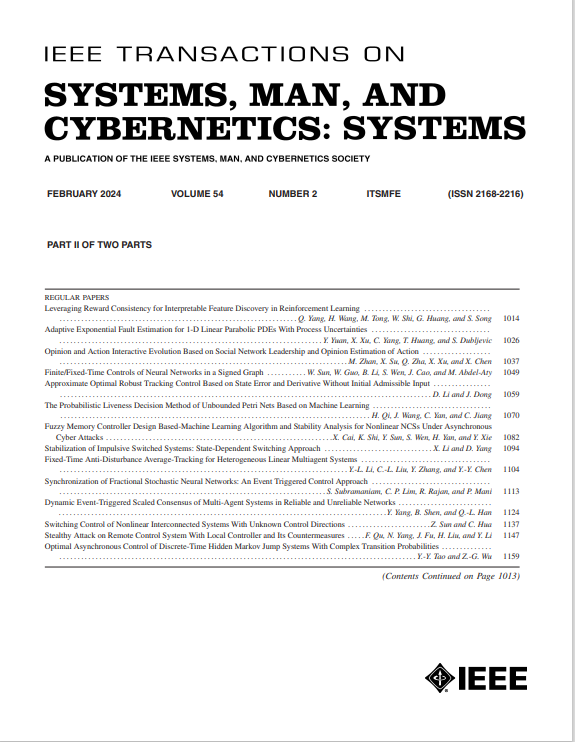输入饱和非完整车辆追逃博弈的动态历史数据强化学习
IF 8.7
1区 计算机科学
Q1 AUTOMATION & CONTROL SYSTEMS
IEEE Transactions on Systems Man Cybernetics-Systems
Pub Date : 2025-08-22
DOI:10.1109/TSMC.2025.3595891
引用次数: 0
摘要
研究了受输入饱和约束的非完整车辆的追踪-逃避博弈,目标是追踪者拦截躲避对手。不同于以往的博弈研究忽略了实际的运动约束,本文建立了一个耦合的非线性系统来阐明参与者之间的相互作用动力学。然后,通过求解一个特殊的非二次代价函数的Hamilton-Jacobi-Isaacs (HJI)方程,推导出最优控制策略。进行了纳什均衡分析和有限时间可捕获性分析。为了学习最优的追求-逃避策略对,提出了一种固定时间收敛强化学习(RL)算法,该算法利用一种新颖的残差设计,通过收集和评估当前和历史数据的信息质量来促进权重更新。与现有的RL方法由于渐近学习规则和严格的持续激励(PE)条件而导致收敛缓慢相比,本文提出的RL方法将PE放宽到一个易于实现和在线可验证的有限激励(FE)条件,允许在固定时间内快速收敛权值。仿真和比较验证了该方法的有效性和优越性,表明与主流RL方案相比,收敛时间缩短了61%。本文章由计算机程序翻译,如有差异,请以英文原文为准。
Dynamic Historical Data-Based Reinforcement Learning for Pursuit–Evasion Games of Nonholonomic Vehicles With Input Saturation
This article studies the pursuit–evasion game involving nonholonomic vehicles constrained by input saturation, aiming for the pursuer to intercept an evasive opponent. Unlike the previous game research neglecting the practical kinematic constraints, a coupled nonlinear system is formulated to elucidate the interaction dynamics between the players. After that, the optimal control strategies are derived by solving the Hamilton–Jacobi–Isaacs (HJI) equation linked to a special nonquadratic cost function. The Nash equilibrium analysis and finite-time capturability are conducted. To learn the optimal pursuit–evasion strategy pair, a fixed-time convergent reinforcement learning (RL) algorithm is proposed, which leverages a novel residual design to facilitate weight updates by collecting and evaluating current and historical data based on information quality. Compared with the existing RL methods that suffer from sluggish convergence due to an asymptotic learning rule and the stringent persistent excitation (PE) condition, the proposed RL relaxes the PE to an easily achievable and online verifiable finite excitation (FE) condition, allowing rapid weight convergence within a fixed period. Simulations and comparisons validate the effectiveness and superiority of the proposed method, showing a 61% reduction in convergence time in contrast to the prevailing RL schemes.
求助全文
通过发布文献求助,成功后即可免费获取论文全文。
去求助
来源期刊

IEEE Transactions on Systems Man Cybernetics-Systems
AUTOMATION & CONTROL SYSTEMS-COMPUTER SCIENCE, CYBERNETICS
CiteScore
18.50
自引率
11.50%
发文量
812
审稿时长
6 months
期刊介绍:
The IEEE Transactions on Systems, Man, and Cybernetics: Systems encompasses the fields of systems engineering, covering issue formulation, analysis, and modeling throughout the systems engineering lifecycle phases. It addresses decision-making, issue interpretation, systems management, processes, and various methods such as optimization, modeling, and simulation in the development and deployment of large systems.
 求助内容:
求助内容: 应助结果提醒方式:
应助结果提醒方式:


